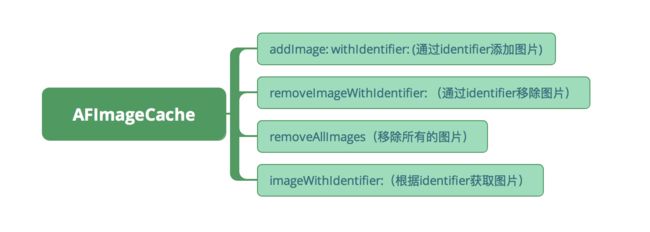之前在UIImageView提到,在开启图片下载任务之前,会先查找缓存中是否有该图片。
//5、如果图片缓存存在,就使用该缓存图片 Use the image from the image cache if it exists
UIImage *cachedImage = [imageCache imageforRequest:urlRequest withAdditionalIdentifier:nil];
查找缓存图片的这个方法- (nullable UIImage *)imageforRequest:(NSURLRequest *)request withAdditionalIdentifier:(NSString *)identifier 来自AFAutoPurgingImageCache这个类。
在AFAutoPurgingImageCache的.h文件中申明了协议AFImageCache。
/**
The `AFImageCache` protocol defines a set of APIs for adding, removing and fetching images from a cache synchronously.
*/
AFImageCache 这个协议有以下4个功能。
还有一个协议AFImageRequestCache,它继承自AFImageCache,又扩展了3个方法。
在AFAutoPurgingImageCache的.m文件中申明了AFCachedImage。
@interface AFCachedImage : NSObject
@property (nonatomic, strong) UIImage *image;
@property (nonatomic, strong) NSString *identifier; //图片标识符
@property (nonatomic, assign) UInt64 totalBytes;//图片总大小
@property (nonatomic, strong) NSDate *lastAccessDate;//最近访问时间
@property (nonatomic, assign) UInt64 currentMemoryUsage; // 当前内存容量
@end
而AFAutoPurgingImageCache的属性中,有一个存放AFCachedImage对象的字典cachedImages。
注意一下,在AFNetworking中,缓存的图片是放在NSMutableDictionary的可变字典中的,不像SDWebImage那样,有做2层缓存处理。
@interface AFAutoPurgingImageCache ()
@property (nonatomic, strong) NSMutableDictionary *cachedImages;
@property (nonatomic, assign) UInt64 currentMemoryUsage;
@property (nonatomic, strong) dispatch_queue_t synchronizationQueue;
@end
了解了AFAutoPurgingImageCache的基本信息,下面倒着来看下这个缓存的方法。
- (nullable UIImage *)imageforRequest:(NSURLRequest *)request withAdditionalIdentifier:(NSString *)identifier {
return [self imageWithIdentifier:[self imageCacheKeyFromURLRequest:request withAdditionalIdentifier:identifier]];
}
这个方法,又是通过图片的identifier来寻找的。
再看这个imageWithIdentifier方法
- (nullable UIImage *)imageWithIdentifier:(NSString *)identifier {
__block UIImage *image = nil;
dispatch_sync(self.synchronizationQueue, ^{
AFCachedImage *cachedImage = self.cachedImages[identifier];
image = [cachedImage accessImage];
});
return image;
}
在 并行队列 synchronizationQueue中,读取图片。
NSString *queueName = [NSString stringWithFormat:@"com.alamofire.autopurgingimagecache-%@", [[NSUUID UUID] UUIDString]];
self.synchronizationQueue = dispatch_queue_create([queueName cStringUsingEncoding:NSASCIIStringEncoding], DISPATCH_QUEUE_CONCURRENT);
此时,cachedImages这个字典派上用场了,通过identifier这个key,寻找对应的AFCachedImage类型的缓存图片。然后通过AFCachedImage类中的accessImage方法,先设置lastAccessDate最新访问的时间为最新时间,再将属性中存储的image返回。
- (UIImage*)accessImage {
self.lastAccessDate = [NSDate date];
return self.image;
}
那这个self.image是怎么来的呢?
再继续往前找,AFCachedImage声明了一个初始化的方法
@implementation AFCachedImage
-(instancetype)initWithImage:(UIImage *)image identifier:(NSString *)identifier {
if (self = [self init]) {
self.image = image;
self.identifier = identifier;
CGSize imageSize = CGSizeMake(image.size.width * image.scale, image.size.height * image.scale);
CGFloat bytesPerPixel = 4.0;
CGFloat bytesPerSize = imageSize.width * imageSize.height;
self.totalBytes = (UInt64)bytesPerPixel * (UInt64)bytesPerSize;
self.lastAccessDate = [NSDate date];
}
return self;
}
这个方法里初始化了AFCachedImage的4个属性,分别是图片image,标识符identifier,totalBytes总大小(字节为单位),lastAccessDate最新访问时间(用于清理内存时,进行排序)。
这个初始化,在AFAutoPurgingImageCache类中,添加图片的方法里会用到。
- (void)addImage:(UIImage *)image withIdentifier:(NSString *)identifier {
//注意,这里使用了dispatch_barrier_async,相当于把block( ^{})中的任务排在了这个并行队列后面,
dispatch_barrier_async(self.synchronizationQueue, ^{
1、先是通过image和identifier初始化一个AFCachedImage
AFCachedImage *cacheImage = [[AFCachedImage alloc] initWithImage:image identifier:identifier];
2、然后通过identifier找到cachedImages中保存的对应对象previousCachedImage
AFCachedImage *previousCachedImage = self.cachedImages[identifier];
3、根据currentMemoryUsage是否存在重新计算currentMemoryUsage。
if (previousCachedImage != nil) {
self.currentMemoryUsage -= previousCachedImage.totalBytes;
}
self.cachedImages[identifier] = cacheImage;
self.currentMemoryUsage += cacheImage.totalBytes;
});
4、另外一个dispatch_barrier_async中,通过currentMemoryUsage和memoryCapacity大小对比,将之前保存的缓存图片数组根据lastAccessDate排序。使用了LRU缓存策略。
dispatch_barrier_async(self.synchronizationQueue, ^{
if (self.currentMemoryUsage > self.memoryCapacity) {
UInt64 bytesToPurge = self.currentMemoryUsage - self.preferredMemoryUsageAfterPurge;
NSMutableArray *sortedImages = [NSMutableArray arrayWithArray:self.cachedImages.allValues];
NSSortDescriptor *sortDescriptor = [[NSSortDescriptor alloc] initWithKey:@"lastAccessDate"
ascending:YES];
[sortedImages sortUsingDescriptors:@[sortDescriptor]];
UInt64 bytesPurged = 0;
5、将重新排序的数组,遍历数组,移除数据直到缓存容量小于等于限值
for (AFCachedImage *cachedImage in sortedImages) {
[self.cachedImages removeObjectForKey:cachedImage.identifier];
bytesPurged += cachedImage.totalBytes;
if (bytesPurged >= bytesToPurge) {
break ;
}
}
self.currentMemoryUsage -= bytesPurged;
}
});
}
“这个方法是核心方法,在这个方法中,一共做了两件事:
把图片加入到缓存字典中(注意字典中可能存在identifier的情况),然后计算当前的容量大小
处理容量超过最大容量的异常情况。分为下边几个步骤: 1.比较容量是否超过最大容量 2.计算将要清楚的缓存容量 3.把所有缓存的图片放到一个数组中 4.对这个数组按照最后访问时间进行排序,优先保留最后访问的数据 5.遍历数组,移除图片(当已经移除的数据大于应该移除的数据时停止)”
参考文章:
AFNetworking 3.0 源码解读(七)之 AFAutoPurgingImageCache

